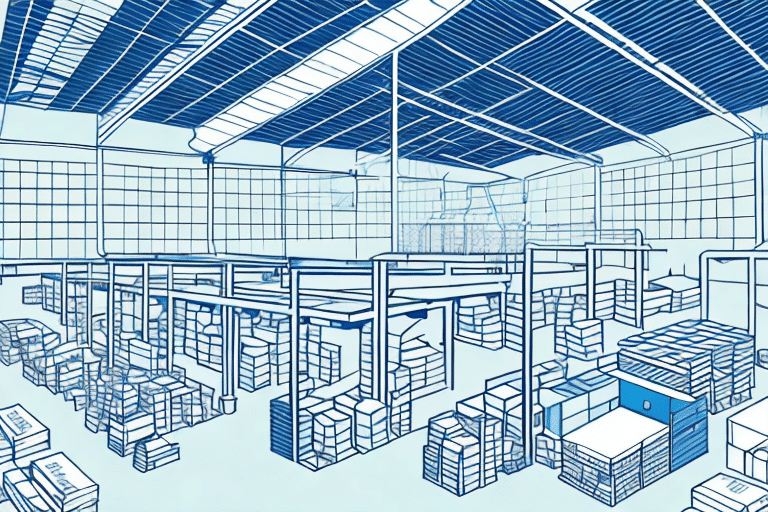A Step-by-Step Guide to Setting Up a Warehouse
Starting a new business can be exciting, but setting up a warehouse that meets your specific requirements and needs can be overwhelming. This guide walks you through the essential steps to establish a successful warehouse, covering everything from assessing your warehouse needs and selecting the right material handling equipment to developing a robust inventory management system that ensures efficient operations. Let's dive in!
Understanding Your Warehouse Needs and Requirements
Before setting up a warehouse, it’s crucial to understand your business needs and requirements. Your warehouse should be tailored to support your business operations effectively. Consider factors such as:
- Storage Capacity: Determine the size and volume of products you’ll be storing.
- Labor Needs: Assess the number of employees required to manage your warehouse operations.
- Equipment Requirements: Identify the type of equipment needed to move and store goods efficiently.
Additionally, evaluate the dynamics of your supply chain, including peak seasons and inventory turnover rates, to ensure scalability and flexibility in your warehouse setup.
Location Considerations
Choosing the right location is a pivotal factor in warehouse success. Key considerations include:
- Proximity to Suppliers and Customers: A location near major suppliers and markets can reduce transportation costs and delivery times.
- Transportation Links: Access to highways, ports, and railroads facilitates smooth logistics operations.
- Security: Ensure the area has low crime rates and consider investing in security systems to protect your inventory.
- Zoning and Regulations: Comply with local zoning laws and industry-specific regulations that may impact your operations.
For data-driven insights, according to the Bureau of Labor Statistics, logistics and warehouse employment continues to grow, highlighting the importance of strategic location planning in supporting expanding operations.
Choosing the Right Location for Your Warehouse
Selecting the appropriate location for your warehouse affects overall efficiency and operational costs. Consider the following factors:
- Proximity to Transportation Hubs: Being close to ports, airports, and major highways can expedite shipping and receiving processes.
- Real Estate Costs: Balance location advantages with the cost of land or rental spaces in the area.
- Labor Market: Access to a skilled workforce ensures smooth operations in inventory management, order fulfillment, and shipping.
- Local Labor Laws and Costs: Understand the implications of local labor regulations and wage standards.
According to a report by Statista, the U.S. logistics market has seen consistent growth, underscoring the value of location in maintaining competitive operations.
Evaluating Your Warehouse Space and Layout
Optimizing warehouse space and layout is essential for enhancing safety, efficiency, and productivity. Key considerations include:
- Storage Areas: Allocate sufficient space for different product categories and consider using vertical storage solutions to maximize space utilization.
- Aisle Widths: Ensure aisles are wide enough to accommodate your material handling equipment, such as forklifts and pallet jacks.
- Goods Flow Optimization: Design the layout to facilitate smooth movement of goods from receiving to storage and finally to shipping areas.
An effective layout can reduce order processing times by up to 20%, according to the Bureau of Labor Statistics.
Selecting the Best Material Handling Equipment for Your Warehouse
The right material handling equipment is pivotal in ensuring your warehouse operates efficiently. Common equipment includes:
- Forklifts: Ideal for moving heavy pallets and large quantities of goods.
- Pallet Jacks: Suitable for smaller loads and narrow aisle configurations.
- Conveyors: Enhance the automation of moving goods within the warehouse.
When selecting equipment, consider:
- Warehouse Size and Layout: Choose equipment that fits the spatial constraints and layout design of your warehouse.
- Product Types: Ensure the equipment can handle the nature and weight of your products, especially fragile or bulky items.
- Capacity and Efficiency: Select equipment that meets your operational demands and enhances productivity.
For more insights on equipment selection, refer to the Material Handling Industry Association.
Developing an Efficient Warehouse Floor Plan
A strategic floor plan is fundamental to maximizing space utilization and operational efficiency. Steps to develop an efficient floor plan include:
- Zone Allocation: Designate specific areas for receiving, storage, order picking, packing, and shipping.
- Equipment Placement: Position equipment to minimize movement and streamline operations.
- Safety and Compliance: Incorporate safety features such as fire exits, lighting, and signage to comply with regulations.
Implementing a well-thought-out floor plan can lead to a 15-20% increase in productivity, as highlighted by Warehouse Management Systems.
Implementing a Robust Inventory Management System
Accurate inventory management is critical for maintaining stock levels, reducing costs, and improving customer satisfaction. To implement an effective system:
- Automated Tracking: Utilize barcode systems or RFID technology for real-time inventory tracking.
- Cycle Counting: Regularly count subsets of inventory to ensure accuracy without disrupting operations.
- Inventory Forecasting: Analyze historical data to predict future inventory needs and adjust stock levels accordingly.
Adopting a Warehouse Management System (WMS) can provide comprehensive control over inventory, improve order accuracy, and enhance overall operational efficiency.
Creating a Safe and Secure Working Environment in Your Warehouse
Safety and security are paramount in warehouse operations to prevent accidents, protect inventory, and ensure employee well-being. Strategies to enhance safety and security include:
- Regular Safety Training: Educate employees on safety protocols and proper equipment usage.
- Equipment Maintenance: Conduct routine inspections and maintenance of equipment to prevent malfunctions.
- Access Control: Implement security measures such as surveillance cameras, secure entry points, and restricted access areas.
- Emergency Preparedness: Establish clear emergency procedures and conduct regular drills.
According to the Occupational Safety and Health Administration (OSHA), maintaining a safe working environment reduces workplace injuries and enhances overall productivity.
Hiring and Training a Productive Warehouse Team
A skilled and motivated team is essential for the smooth operation of your warehouse. Focus on the following aspects:
- Recruitment: Hire employees with relevant experience and skills for warehouse operations.
- Training Programs: Provide comprehensive training on equipment operation, inventory management, and safety protocols.
- Team Building: Foster a collaborative work environment to enhance teamwork and reduce turnover.
- Continuous Development: Encourage ongoing education and skill development to keep the team updated with industry best practices.
Investing in your team can lead to increased productivity and lower error rates, as reported by the Society for Human Resource Management (SHRM).
Best Practices for Warehouse Maintenance and Upkeep
Regular maintenance and upkeep of your warehouse infrastructure and equipment are crucial to prevent downtime and ensure operational efficiency. Key practices include:
- Maintenance Scheduling: Develop and adhere to a maintenance schedule for all equipment to prevent unexpected breakdowns.
- Cleanliness: Maintain a clean and organized warehouse to reduce the risk of accidents and improve efficiency.
- Inventory Checks: Regularly inspect inventory for damage or discrepancies to maintain accuracy.
- Technology Upgrades: Keep your technology systems updated to benefit from the latest features and security improvements.
Implementing these practices can extend the lifespan of your equipment and optimize your warehouse operations, as indicated by Maintenance Technology.
Leveraging Technology to Streamline Your Warehouse Operations
Integrating advanced technology can significantly enhance the efficiency and effectiveness of your warehouse operations. Technological solutions to consider include:
- Warehouse Management Systems (WMS): Automate and manage inventory, order processing, and logistics operations.
- Barcode and RFID Systems: Improve inventory accuracy and speed up the tracking process.
- Automation and Robotics: Utilize automated picking systems and robotic equipment to reduce labor costs and increase throughput.
- Internet of Things (IoT): Implement IoT devices to monitor and manage warehouse conditions in real-time.
- Drones: Use drones for inventory audits and in-monitoring large storage areas efficiently.
Adopting these technologies can lead to a substantial increase in warehouse productivity. For more information, visit Supply Chain Digital.
Optimizing Your Warehouse Workflow to Boost Productivity and Efficiency
Optimizing your warehouse workflow involves streamlining processes to eliminate inefficiencies and enhance productivity. Strategies include:
- Lean Management: Implement lean principles to minimize waste and optimize resource usage.
- Process Automation: Automate repetitive tasks to save time and reduce errors.
- Workflow Analysis: Regularly analyze and refine workflows to adapt to changing demands and operational needs.
Implementing a Warehouse Management System (WMS) further aids in workflow optimization by providing real-time data and analytics, enabling informed decision-making and agile operations.
Measuring and Monitoring Performance Metrics for Continuous Improvement
Tracking performance metrics is essential for assessing the effectiveness of your warehouse operations and identifying areas for improvement. Key metrics to monitor include:
- Order Accuracy: Measure the percentage of orders correctly fulfilled to ensure customer satisfaction.
- Inventory Turnover: Assess how quickly inventory is sold and replaced to manage stock levels efficiently.
- Pick and Pack Times: Monitor the time taken to pick and pack orders to identify bottlenecks.
- Return Rates: Analyze the frequency and reasons for returns to improve quality control and customer service.
Utilize performance dashboards and analytics tools within your WMS to gain insights and drive continuous improvement, as recommended by the Forbes Technology Council.
Addressing Common Challenges in Setting Up a Warehouse
Setting up a warehouse comes with its set of challenges. Common issues include:
- Equipment Malfunctions: Regular maintenance and having backup equipment can mitigate downtime.
- Personnel Injuries: Implementing strict safety protocols and training reduces the risk of workplace injuries.
- Inventory Errors: Implementing accurate inventory tracking systems and regular audits ensures inventory accuracy.
- Fluctuating Demand: Designing flexible operations that can scale up or down based on demand helps manage inventory levels and workforce needs.
Proactive planning and effective system implementation are key to overcoming these challenges and ensuring smooth warehouse operations.
Conclusion: Tips for Success in Setting Up a Successful Warehouse
Setting up a warehouse requires careful planning and strategic execution. By understanding your warehouse needs, choosing the right location, optimizing space and layout, selecting appropriate equipment, implementing robust inventory systems, ensuring safety and security, investing in your team, maintaining regular upkeep, leveraging technology, optimizing workflows, and monitoring performance metrics, you can establish a warehouse that supports your business growth and operational efficiency. Follow these tips to pave your way to a successful warehouse setup.




















